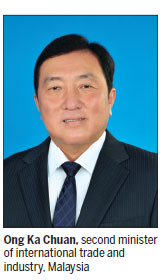ASEAN pursues regional challenges to boost growth
Updated: 2016-05-18 08:18
(HK Edition)
|
|||||||||
Editor's note: Sitting on the Maritime Silk Road, the ASEAN is a significant stop among the Belt and Road regions. It is also a rising destination for China's booming outbound investment. As the Belt and Road Summit opens in Hong Kong on Wednesday, China Daily's Hazel Chen has spoken to diplomats from some major ASEAN countries to share their views on the Belt and Road Initiative. Interviewees include Ong Ka Chuan, second minister of international trade and industry, Malaysia; Agus Cahyono Rasyid, consul for economic affairs, Indonesian consulate general in the Hong Kong SAR; and Bernardita L. Catalla, consul general, consulate general of the Philippines in the Hong Kong SAR.
Q: From your country's perspective, what is by far the most significant development in the construction of Belt and Road (B&R) Initiative?
Ong: Malaysia welcomes the B&R as it will create more opportunities and revitalize the economy along its route. Malaysia is strategically located along the B&R route and even in the early 15th century, Malaysia was the hub of trade activity connecting the East to the West.
Due to Malaysia's importance along the B&R route, the Malaysian government had endorsed the establishment of "Friendly State and Province" between the State of Malacca and Guangdong province. This strategic partnership will promote the development of various projects which will contribute to the development of Malacca as a strategic port and hub along the B&R route.

The cooperation between Guangdong province and Malacca included the construction of a Maritime Industrial Park, the Guangdong-Malacca Industrial Estate, the construction of a deep-sea port in Melaka city and the construction/provision of land-use areas for purposes of trade and commerce.
The increased connectivity between Malacca and Guangdong province via the expansion of the international airport in Malacca that will soon provide direct flight services to China will enhance tourism and industrial development in Malacca.
Rasyid: The B&R Initiative has a great impact on the world. From my country's perspective, it boosts the intensifying effect for the cooperation of both sides (Indonesia-China). The most significant development of China's approach to Indonesia under the B&R is that, last year, our government came into agreement with the Chinese government to build a high-speed rail project in Indonesia, albeit we learned of the fact that Japan had also submitted its bid for the same project.
Catalla: The speed with which the Chinese government conceptualized, planned, and implements the B&R is nothing short of remarkable. Since President Xi Jinping first announced the idea of B&R in October 2013, the National Development and Reform Commission has already come up with its Vision and Actions on Jointly Building the Silk Road Economic Belt and 21st-Century Maritime Silk Road. In addition, the Silk Road Fund and the Asian Infrastructure Investment Bank (AIIB) are being put in place to fund infrastructure projects that will be implemented under the B&R, among others.
Q: What do you expect most from the B&R construction? What kind of projects, plan, or opportunities do you wish the B&R bring to your country?

Ong: The B&R is an important catalyst for the development of economies along its route and creates various spillover effects as well as economic opportunities in trade, investment and tourism.
These developments will further promote regional cooperation and increase connectivity in various areas and linkages in a wide range of sectors. Ultimately, the B&R will pave the way for regional peace and establish the platform for increased interaction and engagement for a better economic future for all the countries along the B&R route.
As for Malaysia, we welcome more trade investment flows from China as both countries had agreed to elevate our relationship to comprehensive strategic partner and had set the trade target of $160 billion by 2017.
Malaysia welcomes more investments, particularly in new growth areas within the emerging technologies, high-tech, high value-added, knowledge-based, skills-intensive, export-oriented, capital-intensive sectors and those that provide high-income jobs, such as the following areas:
Infrastructure development
Halal Park
Logistics
Manufacturing sector especially in electrical and electronics, chemicals, machinery and equipment. High potential growth subsectors namely aerospace and medical devices have also been identified in the 11th Malaysia Plan to drive the growth of the manufacturing sector
Services sector especially knowledge-intensive services to develop high-skilled human capital and create high-income jobs, financial services, ICT (information and communications technology), O&G (obstetrics and gynaecology) services, private healthcare, private higher education, tourism, halal industry, wholesale and retail trade, construction industry and professional services.
Eventually Malaysia would like to position itself as the hub for ASEAN (Association of Southeast Asian Nations) countries and also to serve as a regional hub for countries along the Maritime Silk Route.
Rasyid: The B&R is actually in line with the concept of maritime axis introduced by the Indonesian President, Mr Joko Widodo, in which Indonesia, which geographically lies between two continents (the Asian and Australian continents) and two oceans (the Pacific and Indian oceans), has major benefits as it can make an important axis for the world in the concept of geo-political and geo-economic cooperation. Viewing this very similar concept with B&R as an important milestone, Indonesia sees the cooperation with China under the B&R as of paramount importance.
The Indonesian government currently focuses on attracting investment for infrastructure projects, and we hope that through the platform offered by the Hong Kong government under the B&R, we can promote our prioritized projects.
Catalla: The Philippines has been enjoying the fruits of fiscal and other reforms that have been implemented these past years. However, with an archipelago comprising more than 7,100 islands and a population of 100 million and growing, the government has to ensure that economic growth is inclusive and sustainable so that the maximum number of Filipinos are lifted out of poverty, similar to China's amazing transformation of the past 37 years.
Massive and quality infrastructure development will spur economic and social development. The country's Public-Private Partnership Center (www.ppp.gov.ph) has listed various projects that will be bid out for construction, including power plants, airports, seaports, railways, roads, hospitals, schools, flood control structures, and heritage and urban renewal projects, among others. We trust that the B&R will bring more foreign investors not only to participate in infrastructure programs but also to set up manufacturing plants in the Philippines.
Cooperation in non-economic areas such as educational exchanges, training on cultural festivals, tourism, maternal and child health, science and technology, and projects on environment and ecological protection can benefit both China and participating economies in the B&R route.
As a super-connector between the Chinese mainland and B&R countries, Hong Kong has expertise in financial, legal, and engineering services, while the Philippines has a huge pool of technical and professional human resources. Hong Kong and the Philippines can strongly complement each other in enhancing their robust partnership on the economic front.
Chinese mainland and Hong Kong companies are welcome to visit the Philippines and see for themselves the potentials of doing business in the country.
Q: What is your advice to China on better promoting the B&R construction? What kind of challenges do you see in this grand plan and how should they be addressed?
Ong: In ensuring the B&R is well-understood and welcomed by countries along the route, there is a need for China to come up with an action plan. This plan should detail all the major projects and programs for the participating economies to consider. This will also increase engagement between all parties involved in order to dispel any doubts and uncertainties.

The implementation of B&R is surrounded by many challenges as it is not easy to get the agreement of so many countries which differ in their development. There is a need for regular consultation and establishing this proper consultation mechanism is the key for the success of the initiative as it will provide the participating countries with the means to discuss and overcome the challenges faced.
Catalla: In his recent visit to Hong Kong, AIIB President Jin Liqun assured the audience that best practices and measures derived from other multilateral institutions such as the World Bank and the Asian Development Bank are in place to ensure that all disbursement of funds will not be tainted by any irregularities. This is encouraging to know because nothing undermines trust in a system faster than corruption.
The Philippines is also a leading member of the ASEAN, a 10-country bloc with more than 600 million people and a combined GDP of $2.6 trillion, the seventh-largest in the world. Most of these economies can benefit from investments in infrastructure and social services especially because China has included Southeast Asia among its areas of focus.
A partnership geared for achieving a win-win goal ought to be the guiding principle to bind a long-lasting friendship and cooperation among neighbors such as the Philippines, Hong Kong and the Chinese mainland. It is essential that a program, initiative, or project upholds and observes transparency, fairness, and reason to ensure success.

(HK Edition 05/18/2016 page10)